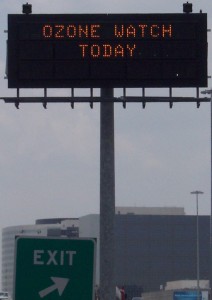Power of the Press: Week after Trib Report on DFW Smog, First “Exceedences” of 1997 Standard
 It was only eight days ago the that online Texas Tribune did the first real overview of DFW air quality for this "ozone season." Borrowing heavily from the June 16th Downwinders at Risk presentation to the North Texas regional air quality committee, it concluded that there had been no discernible progress in regional air quality for the past five to six years despite a new state anti-smog plan aimed at getting the area below the 1997 standard of 85 parts per billion.
It was only eight days ago the that online Texas Tribune did the first real overview of DFW air quality for this "ozone season." Borrowing heavily from the June 16th Downwinders at Risk presentation to the North Texas regional air quality committee, it concluded that there had been no discernible progress in regional air quality for the past five to six years despite a new state anti-smog plan aimed at getting the area below the 1997 standard of 85 parts per billion.
Ironically, up to that point, DFW had been enjoying one of the wettest, coolest, most ozone alert-free summers on record. Not one 100 degree day until July and only one "bad air" days of note on June 11th. It looked like we might actually be able to meet the 1997 standard of 85 ppb for the very first time.
That's all changed with this past weeks' return to familiar form. In just seven days, they've been at least four official "ozone alerts" issued for DFW by the Texas Commission on Environmental Quality. Those had produced four "exceedences" of the current 75 parts ppb standard, which the state is now aiming at with another "do nothing" plan under development and due out by the end of the year. On Wednesday the trend got more serious with the addition of the first two "exceedences" of the older 1997 standard we can't seem to conquer – a reading of 88 ppb at the NW Fort Worth monitor at Meacham Field and a 91 at the usually quiet Granbury monitor in Hood County. In the latter case, one mid-afternoon hourly reading reached as high as 113 – just 12ppb short of a violation of an even more ancient standard left over from the 1980's.
For comparison's sake, EPA scientists just sent a letter to EPA Administrator Gina McCarthy recommending that a new, lower federal standard for ozone be set at 60-70 ppb.
It will still take another week of 85 ppb plus days to produce the "fourth highest" readings at the Denton or Keller sites to combine with their 2013 averages and keep DFW in violation of a 17-year old ozone standard. But then again, we have all of August and September to go.
Not surprisingly, two of this summer's hot spots include traditionally troublesome monitors – the Denton and NW Fort Worth site. Tarrant and Denton Counties have historically been the places where the region's highest readings have originated. One reason is wind direction – smog accumulates from upwind sources like the Midlothian cement plants and blows Northwest during the summer. Another more recent reason is the mining of Barnett Shale gas deposits that release huge quantities of smog-forming pollution in the western half of the Metromess, a phenomenon that's been examined in a new UNT study that divided the region's ozone monitors into "Fracking" and "Non-Fracking" areas and found significantly higher readings among those in the Fracking area.
As we went to press with this post, Thursday's readings looked to be producing another round of 75 ppb or higher results. Adding to this year's ozone season irony is that over the last 20 years, July has traditionally been the summer month that produced the fewest number of high ozone readings, book-ended by higher numbers in June and August-September.
Depending on the weather, DFW may still be able to make it over the 1997 standard, 85 ppb hump. But based on this past week's results, that hump just got bigger. Stay tuned.
